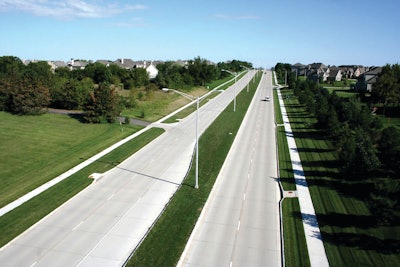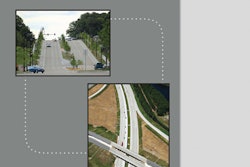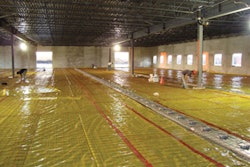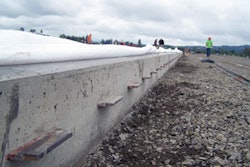
In pavement design and construction, there are many opportunities to improve sustainable practice. For the highway engineer, sustainability initiatives are usually focused on structural design, the pavement materials or the construction operation itself. As agencies increase their understanding of the sustainability impacts associated with the construction and operation of roadways and pavements, and as research into sustainable practices continues to evolve and advance, the awareness of life cycle analyses and use-phase impacts will continue to grow.
Emerging approaches
It is important to look at the concept of “cradle-to-grave” analysis, which has emerged in the pavement arena. Carrying an analysis from cradle-to-grave is the central idea of a life cycle assessment (LCA). LCA allows for a sophisticated and complete means of examining resource use and availability and was in the late 1990s standardized by the International Organization for Standardization (ISO). The purpose of the LCA approach is to ensure that all the effects, factors, loads, etc., are accounted for in the analysis, from the moment any component is extracted or processed, all the way to its end of life. It essentially involves a cumulative analysis of a product’s environmental or sustainability impact throughout all stages of the product’s life cycle, including impacts not usually considered in more traditional analyses. Figure 1 illustrates the concept of a LCA, including inputs, outputs and the system boundary.
A comprehensive LCA study undertaken by Centre d’Energétique de l’Ecole des Mines de Paris (Mines Paris Tech) examined the impact of six different pavement structures in reference to 12 different environmental factors (including greenhouse gases, energy, ecotoxicity, smog, odor, solid waste, etc). (Figure 2.)
From the analysis it can be seen that the overall impact from the use-phase dwarfs impacts from all other phases of the pavements life cycle. In fact, with the sole exception of the solid waste factor, the impact of the use-phase (traffic in this case) is at least 10 times greater than all other phases. Just a 2 or 3 percent improvement in the truck traffic and car traffic portions of the ecoprofile would essentially offset the entire construction and maintenance ecoprofile. Recent and ongoing research conducted by the Massachusetts Institute of Technology (MIT), Technische Universität München (TUM), National Concrete Pavement Technology Center (CPTech Center) and others are drawing similar conclusions.
Essentially because pavements remain in service for decades, lying exposed every hour of every day, and typically supporting millions of vehicles during that time, use-phase impacts are likely to be the dominant factor when assessing sustainability and should therefore be the chief focus of our efforts. The most prominent of these impacts likely come from either vehicle fuel consumption rates (related to pavement rigidity and smoothness), or pavement albedo (as it relates to urban heat island, lighting and global cooling).
Vehicle fuel consumption and pavement
Since 1989, several important studies have examined the link between vehicle fuel consumption rate and pavements. Most of the studies suggest that because vehicles (particularly trucks) cause greater deflections on flexible pavements than on rigid pavements, more of the energy intended for propelling the vehicle is absorbed, causing those deflections.
Arguably the most statistically rigorous of these efforts, a comprehensive, multi-phase study on the effects of pavement structure on vehicle fuel consumption, was published in 2006 by the National Research Council Canada. The study concluded that tractor-trailers traveling on rigid pavements consume significantly less (on average about 3.8 percent) fuel than those traveling on flexible pavements. Research is ongoing at the MIT’s Concrete Sustainability Hub to verify and expand on this work.
Pavement smoothness is also a factor. The smoother a pavement is, the less fuel that will be required to propel vehicles along the roadway. Any roughness along the way will translate into vertical motion and consequently heat in vehicle suspension systems, leaving less energy available for forward motion. This concept is very similar to the hypotheses associated with rigid versus flexible pavements. Any energy that is “bled-off” to do such things as deflect the pavement, or excite the suspension system, will not be available to propel the vehicle forward. Hence, more energy is required to propel the vehicle, and fuel economy suffers.
A number of studies published since 1990 suggest there are significant fuel consumption efficiency gains associated with pavement smoothness gains. A Federal Highway Administration report published in 2000 suggests that a reduction in International Roughness Index (IRI) from 150 in./mile to 75 in./mile (i.e., improvement in smoothness) on asphalt pavement results in an accompanying 4.5 percent improvement in truck fuel economy.
These benefits are relevant not only for new pavements (i.e., specifying smooth pavements), but it is also important when deciding on maintenance strategies and schedules. Diamond grinding is a particularly useful technique used to restore pavements and improve smoothness. This can extend the service life of a smooth concrete pavement to twice its normal design life.
Light reflectance
The other critical operational-phase impact that should be considered in a sustainability assessment relates to concrete pavement’s capacity to reflect light. This characteristic of pavement, generally referred to as albedo or solar reflectance, is a function of both type and age of the material. This has obvious visibility and safety implications, but the higher albedo that concrete pavement can provide is advantageous for other important sustainability-related reasons as well. High albedo pavements can significantly reduce the amount of energy needed for artificial roadway illumination during nighttime.
High-albedo or cool pavements can also reduce the amount of energy needed to cool urban environments associated with the urban heat island effect. Cool pavements can also mitigate the greenhouse effect and contribute to global cooling by reducing the amount of solar radiation absorbed by the earth’s surface.
The use of high albedo pavements has a significant sustainability impact and may even prove to be a useful tool in helping mitigate climate change. Moreover, because pavements remain in service for decades, lying exposed every hour of every day, the cumulative impact of these use factors over the pavement service life are enormous.


















